Bonsai Techniques
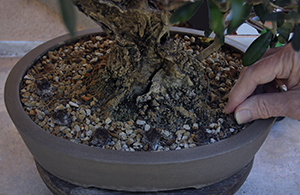
Fertilizing
by Lew Buller
Japanese bonsai masters have been coming to California for years, either to demonstrate at conventions or to visit friends, or both. When they visit the bonsai collections here, they politely state “Your trees are under-fertilized.”
When Kathy Shaner brought her teacher, Yasuo Mitsuya, to my back yard, both were very polite and did not mention fertilizing. He was fascinated by the bougainvillea in my back yard and later, Kathy was able to find a large one and send it to him in Japan.
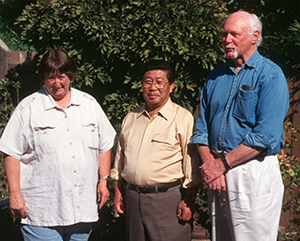
Most of us can do better by understanding more about plants and their needs and providing for them. If you are going to be good at bonsai, there is no way you can avoid learning some basic chemistry. A book by Brian Capon, Botany for Gardeners, is available from Amazon and will go a long way toward helping you understand.
Fertilizer may be organic, meaning it was derived from materials that were once alive, or it may be inorganic, from minerals and other materials that were never alive. Organic fertilizer must first be converted to inorganic salts, a process which can take from 2 to 12 weeks or more, before it can be taken up by plants. The advantages of organic fertilizers are that the effects last a long time and it is difficult to over fertilize.
Inorganic fertilizer needs little or no conversion before it can be taken up by plants. For this reason caution is urged in the use of inorganic fertilizer on bonsai; the plant may have far more fertilizer available than it can use and suffer bad results. Either follow the instructions scrupulously or feed half as much as directed but twice as often.
Inorganic fertilizer may be applied to the soil but also may be applied as a foliar spray if it is in the form of water soluble salts. There is some research which says that more nutrients, phosphate especially, are absorbed by stomata in the leaves from foliar spraying than are absorbed by roots from fertilizer in the soil. Many bonsai growers use a balanced program including both foliar feeding and root feeding
Above ground activity in plants goes on during daylight hours; root activity goes on 24 hours a day if the temperatures are right. Therefore, foliar feeding should be in the morning with the fertilizer well dissolved and the spray mist as fine as possible. The chemicals will be taken up for as much as two hours.
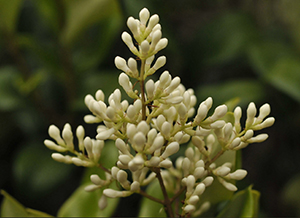
If I let the Japanese privet go untrimmed in the spring, it will produce flowers like the one shown. It temporarily spoils the outline but trimming the flowers off restores it.
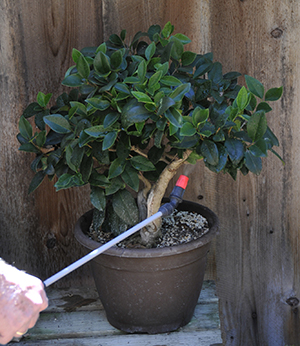
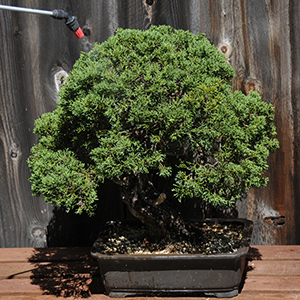
Broad-leaved trees like the wax- leafed privet usually have their stomata on the lower surface, so spray from the bottom up. The scales (leaves) on junipers will have stomata on all sides, so spray to cover all surfaces.
Plants need 16 separate chemicals for transpiration, respiration, and growth. Three of the elements are readily available from air and water, specifically carbon, oxygen, and hydrogen, making it clear why a regular program of watering and a well-draining soil that allows oxygen to the roots are important to bonsai growth.
If the chemical element is in soluble form, it will move through the soil and can be taken up by plants, but it can also be leached out of the soil. If the element is in insoluble form, it is not available to plants and generally will not leach out of the soil. Solubility is one of the reasons soil should be moist before fertilizer is added; the fertilizer can disperse and move through the soil.

In nature, rain falls on tree leaves and runs to the outside of the tree, falling on what is called the drip line. New roots are constantly moving toward this drip line to get water and picking up nutrients in the process. In bonsai, the pot is only about two-thirds the width of the drip line and the entire surface of the soil is watered. How can roots be encouraged to move out away from the center toward the outside? Put the fertilizer cakes fairly close to the edge of the pot and new roots will reach for them, even if they don’t need to reach for water.
New roots are more efficient than old roots in picking up water and fertilizer. The older a root becomes, the more it becomes a pipeline and the less water and nutrients it takes up. That’s why you are encouraged to cut off large old roots when possible. New roots are likely to grow out from the cut surface of the old root.
Bonsai growers should fertilize regularly, with intervals ranging from one week to one month, depending on the type of material being dispensed and the season. Some growers recommend using a variety of fertilizers on the theory that what one lacks, another will provide; others rely on a single fertilizer such as fish emulsion or cottonseed meal.
Plants make limited use of nutrients from fertilizers until leaves are developed to accomplish photosynthesis. In trees such as flowering apricots, quince, and azaleas, flowering marks the beginning of the end of dormant season. Active growth does not begin until flowering is fairly well completed; thus the instruction to transplant after flowering, when the plant is beginning its most active growth period. No nitrogen fertilizers should be given during flowering; the plant can’t use them but it will try to, trying to grow green vegetation when it should be flowering.
A healthy plant properly fertilized the previous year will have sufficient reserves of its own to establish new leaves in the spring. Organic fertilizer needs decomposition and conversion to inorganic salts, so its application should be timed to coincide with the trees’s needs after new leaves are established. The easy way to do this is to add cottonseed meal to the soil mix at transplanting; two to six weeks later, when the tree has leafed out, soil bacteria will have converted the cottonseed meal to inorganic salts available to the roots. With inorganic foliar sprays, timing can be precise; the nutrients are available immediately.
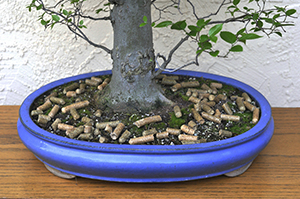
Cottonseed meal used as a top dressing should be scraped off completely after a month, or, better yet, applied as dango (“dumplings”) which will release nutrients yet not rot and disappear into the soil, avoiding conditions favorable to root rot. In addition to cottonseed meal cakes (See “Helpful Hints - 2 for instructions on making them), I use alfalfa pellets with 2-1-1 NPK as a mild organic fertilizer and also for two other reasons. They contain triacontanol, a root stimulant, and after they have been watered a few times, they swell up and become mulch, keeping water from evaporating and the soil from becoming excessively hot. The pellets are available in feed stores and are very economical.
Not all trees require the same amount of fertilizer. Trees such as azaleas and pines developed in nutrient poor soils; excessive fertilizer will harm if not kill them Know your tree! Generally, nutrients are taken up better when the soil is near neutral or slightly acid, with a pH in the 6.0-7.0 range except that flowering trees like a slightly more acid soil.
Learn how to adjust the acidity of your soils. Making the soil more acidic frees micronutrients already present in the soil. Adding soil sulfur is the most effective way to acidify the soil. Miracid, with a ratio of 30-15-15, is recommended for acid-loving plants. The high nitrogen level results in increased acidity.
Evergreen conifers (junipers and pines) can be fertilized year-round in San Diego, although the amount of fertilizer should be reduced. Some photosynthesis continues down to temperatures around 40o, so growth continues and nutrients are necessary, especially since continued watering and spring rains leach nutrients out of the soil.
Deciduous trees should be fertilized as they move into their strong growing season, with fertilizer reduced as temperatures peak (especially for azaleas, even the evergreen types) and then changed to a non-nitrogen fertilizer as dormant season approaches. These are general suggestions; in the final analysis, learn the requirements of the individual tree. Your trees will tell you whether you are doing the right thing.
In summary:
1. Water in dry fertilizers thoroughly after application.
2. Water plants before applying liquid fertilizers to the soil.
3. Apply at half strength or less but twice as often as recommended.
4. Most fertilizers need to be kept dry; they tend to be anhydrous and absorb moisture if they are not kept tightly packaged.
5. Fertilizers will stain if they are dropped on concrete and not swept up while they are dry.
